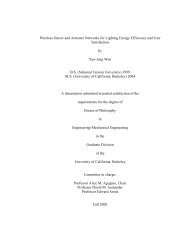Metaphors in Conceptual Design - Berkeley Expert Systems ...
Metaphors in Conceptual Design - Berkeley Expert Systems ...
Metaphors in Conceptual Design - Berkeley Expert Systems ...
Create successful ePaper yourself
Turn your PDF publications into a flip-book with our unique Google optimized e-Paper software.
volition. Creative <strong>in</strong>spiration employs the metaphor Know<strong>in</strong>gIs See<strong>in</strong>g with Ideas Are Light Sources [2]. In this way, Ideasare the illum<strong>in</strong>ation, the creative spark or the flash that light upa portion of the design space or illum<strong>in</strong>ate a solution directly.F<strong>in</strong>ally, the metaphor Problems Are Gaps or Obstacles leadsunderstandably to the common notion of the ‘creative leap.” Inthe creative leap we move locations, and therefore states, viathe common metaphor States Are Locations [6].The ‘out of our control’ nature of metaphors for creativeideas, together with the spontaneity implied takes the emphasisoff the hard work that is needed for creative design. ConsiderEdison’s mantra “Genius is 1% <strong>in</strong>spiration and 99%perspiration,” or the advice of Bernie Roth at StanfordUniversity that “Hard work is the best creativity method Iknow” [44]. The metaphors also highlight the <strong>in</strong>dividualcontribution of creative activity perpetuat<strong>in</strong>g the myth of thelone <strong>in</strong>ventor and down play<strong>in</strong>g the role of constructivecollaboration <strong>in</strong> teams.Summary and future work<strong>Metaphors</strong> are frequently used <strong>in</strong> the design process. Thisresearch qualitatively describes their use <strong>in</strong> a representativesample of textbooks <strong>in</strong> eng<strong>in</strong>eer<strong>in</strong>g design. This research laysthe foundation for future work <strong>in</strong> identify<strong>in</strong>g how metaphorscan enrich and expand the design process and where they may<strong>in</strong>hibit or restrict creative design.Follow<strong>in</strong>g an analysis of the language used <strong>in</strong> the conceptgeneration chapters of n<strong>in</strong>e widely used eng<strong>in</strong>eer<strong>in</strong>g designtextbooks we presented both the metaphors <strong>in</strong> use for the coredesign concepts of Ideas, Problems and Solutions, as well asthe overall metaphor for design itself. We found that differentoverall perspectives on design leads to different metaphors forthe core design concepts. For example, a view of <strong>Design</strong> IsSearch is likely to employ the metaphor Problems AreLocations, whereas a view of <strong>Design</strong> Is Decomposition is likelyto employ the metaphor Problems Are Objects.We are follow<strong>in</strong>g several avenues for further research. We<strong>in</strong>tend to develop this study by compar<strong>in</strong>g the metaphors <strong>in</strong> useby design authors and the impact on the more concrete designmethods they recommend. By extend<strong>in</strong>g the analysis beyondthe conceptual design chapters we also hope to evaluate ifpatterns are present throughout the entire approach of anauthor. Also, while this study draws on the metaphors <strong>in</strong> use <strong>in</strong>design education as ‘transmitted’ through design textbooks, we<strong>in</strong>tend to verify whether the same metaphors are <strong>in</strong> use bydesign students after study<strong>in</strong>g product development. To this endwe are currently repeat<strong>in</strong>g the analysis us<strong>in</strong>g verbal protocolanalysis of design discourse from design students. As our goalis to better understand how metaphors affect creative design wefurther hope to test the effect of different metaphor models fordesign through experiment.ACKNOWLEGDEMENTSWe thank Alan Shih for his assistance <strong>in</strong> data gather<strong>in</strong>g andanalysis for this study. This research was partially funded byNSF grant DUE-0428935REFERENCES[1] Boroditsky, L. Metaphoric Structur<strong>in</strong>g: Understand<strong>in</strong>gtime through spatial metaphors. Cognition, 2000, 75(1),1-28.[2] Lakoff G. and Johnson M. <strong>Metaphors</strong> we live by, 1980(University of Chicago, Chicago)[3] Kövecses Z. Metaphor: A Practical Introduction. 2002(Oxford University Press, New York).[4] Kelley T. and Littman J. The Art of Innovation, 2001(Doubleday, New York).[5] Gabora L. Cognitive mechanisms underly<strong>in</strong>g thecreative process. In Proceed<strong>in</strong>gs Creativity andCognition IV, Loughborough, 2002, pp.126-133.[6] Lakoff G. and Johnson M. Philosophy <strong>in</strong> the Flesh: TheEmbodied M<strong>in</strong>d and its Challenge to Western Thought,1999 (Basic Books, New York).[7] Gentner D. and Gentner D.R. Flow<strong>in</strong>g waters orteem<strong>in</strong>g crowds: Mental models of electricity. InGentner D. and Stevens A.L. (Eds) Mental Models,1982, pp. 99-129 (Lawrence Erlbaum Associates,Hillsdale, NJ).[8] Carroll J.M. Mack R.L. and Kellogg W.A. Interface<strong>Metaphors</strong> and User Interface <strong>Design</strong>. In Helander M.(Ed.), Handbook of Human-Computer Interaction,1988, pp.67-85 (Elsevier Science Publishers B.V.,North- Holland).[9] Maglio P.P. and Matlock T. The conceptual structure of<strong>in</strong>formation space. In Munro A. Benyon D. and Hook K.(Eds.), Social navigation of <strong>in</strong>formation space, 1999,pp.155-173 (Spr<strong>in</strong>ger Verlag, London).[10] Cooper A. The Myth of Metaphor. Visual BasicProgrammers Journal, 1995.[11] Lawler J.M. <strong>Metaphors</strong> We Compute By. In Hickey D.(Ed) Figures of Thought: For College Writers, 1999,pp.411-422 (Mayfield Publish<strong>in</strong>g, Mounta<strong>in</strong> View).[12] Mohnkern K. Beyond the <strong>in</strong>terface metaphor. SIGCHIBullet<strong>in</strong>, 1997, 29(2), pp.11-15.[13] Stubblefield W.A. Patterns of Change <strong>in</strong> <strong>Design</strong>Metaphor: A Case Study, Proceed<strong>in</strong>gs of the SIGCHIconference on Human factors <strong>in</strong> comput<strong>in</strong>g systems, LosAngeles, California, April 1998, pp.73-80.[14] Nonaka I. The Knowledge-Creat<strong>in</strong>g Company. HarvardBus<strong>in</strong>ess Review, 69, 1991, pp.96-104.[15] Hertzfeld A. Bicycle. Retrieved January 2007, fromhttp://www.folklore.org/StoryView.py?project=Mac<strong>in</strong>tosh&story=Bicycle.txt[16] Schon D.A. Generative metaphor: a perspective onproblem sett<strong>in</strong>g <strong>in</strong> social policy. In Ortony A. (Ed)Metaphor and Thought, 1979, pp 254-283 (CambridgeUniversity Press).9 Copyright © 2007 by ASME
















